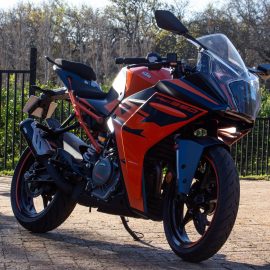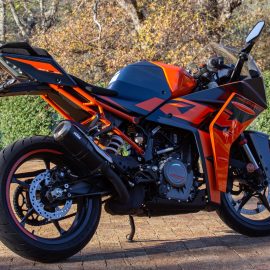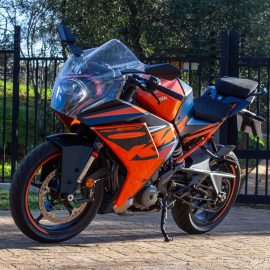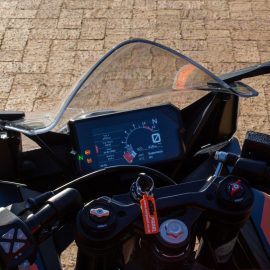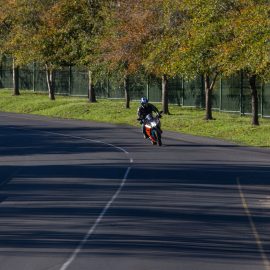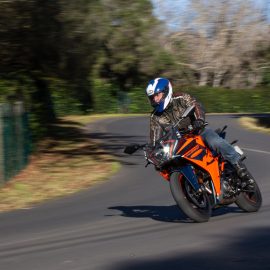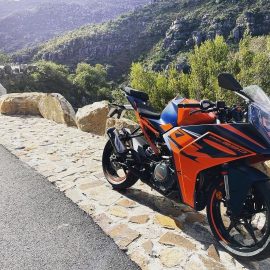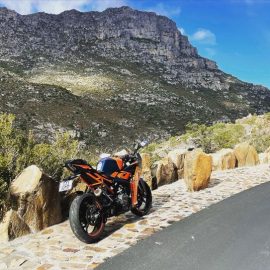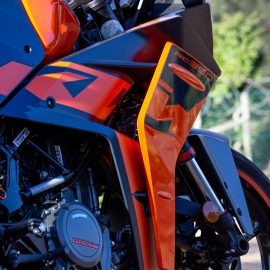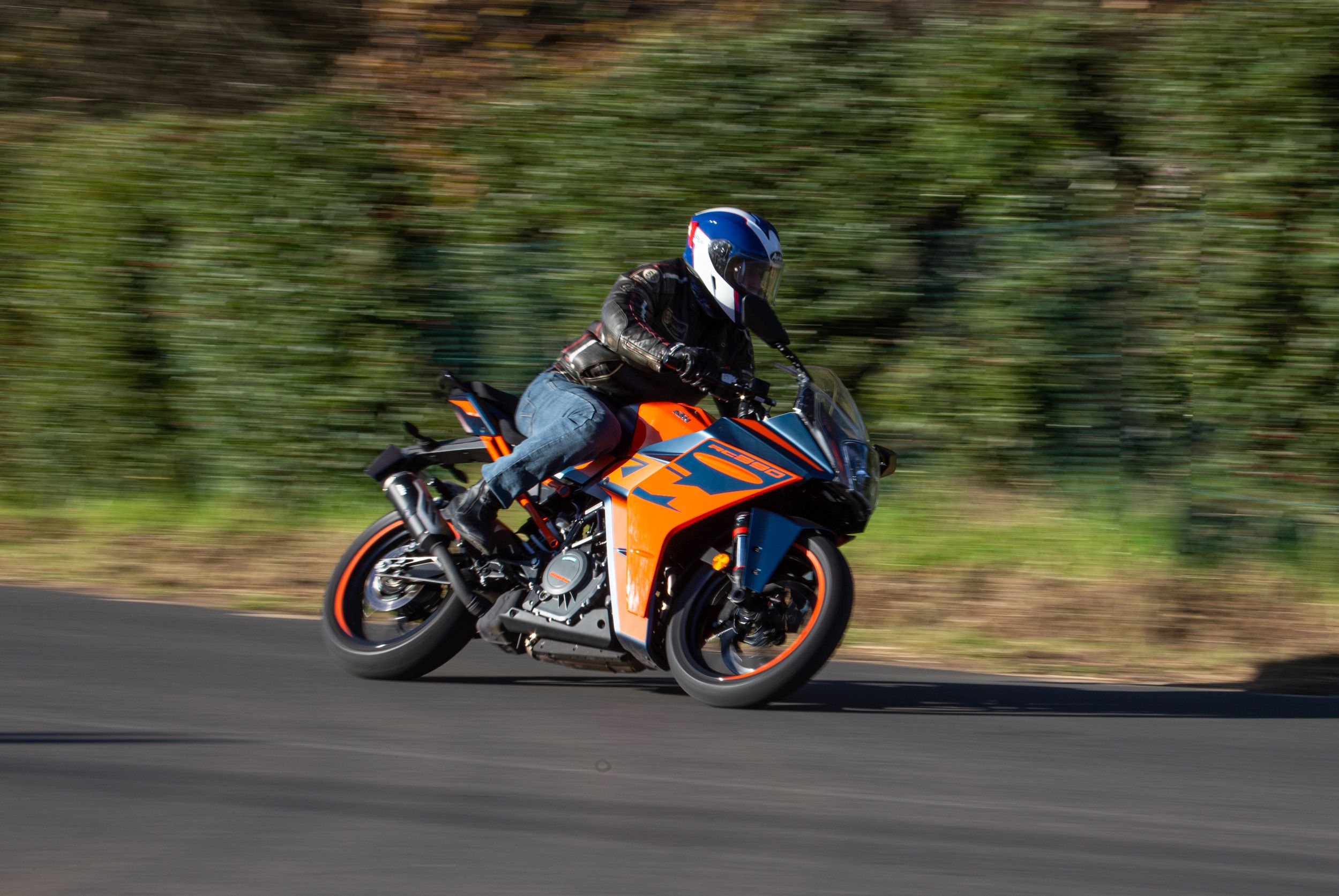
01 Aug On Yer Bike: KTM RC390
FMM Curator Wayne explains the History of KTM and describes his weekend with an RC390…
In the world of motorcycles, KTM is often seen as the new kid on the block, but its roots can be traced back as far as 1934 to the Austrian town of Mattighofen. This was where Johann Trunkenpolz set up a small garage to sell and repair DKWs and Opels. With the outbreak of WWII, Trunkenpolz and his small company Kraftahrzeug Trunkenpolz Mattighofen became successful repairing diesel engines for the war effort. However, after the war it was a different story and business slowed down. So, in 1951, Trunkenpolz decided to build his own motorcycles using Sachs Rotax engines.
In 1953, Ernst Kroneif became a major shareholder of the then Trunkenpolz Motorcycle Company, which at that stage was producing only three motorcycles a day. The name changed again when Kronreif & Trunkenpolz Mattighofen was registered. Three years later, KTM was winning titles and new models like the Tourist and Mirabell were being sold under the KTM name. Many other models soon followed, including a line of bicycles in the 1960s but, sadly, both Kronreif and Trunkenpolz passed away at this time.
Now under the leadership of Trunkenpolz’ son Erich, KTM again boomed and by 1971 the company produced over 70 different models of motorcycles, a line bicycles as well as radiators for the car industry. Unfortunately, 1988 saw the KTM business slump very badly as Erich passed away, leaving KTM in dire straits. After a number of restructures, in 1992 KTM Motoradholding GmbH was formed under the guidance of Stefan Pierer. At this time KTM, acquired both Husaberg AB and Husqvarna, introduced the Duke range of motorcycles, adopted its trademark orange colour and finally took on the GasGas motorcycle brand and line up.
Today KTM AG is a force to be reckoned with and is at the sharp end of the motorcycle industry. Many South Africans have taken to following KTM as a brand, thanks in part to our local world champion Bard Binder, who currently heads up the KTM (Red Bull) works MotoGP team. And let us not forget the legendry Alfie Cox and his Dakar titles with KTM that we featured in the April 2020 FMM newsletter.
So, what is a modern KTM like to ride? Having never ridden a KTM before, I couldn’t refuse the offer to test ride one of their motorcycles. KTM’s new Paarl dealership is just up the road from the museum and they kindly invited me to come and have a look around their showroom. With the high price of fuel reviving my interest in high-output small-capacity motorcycles, I requested the new RC390 for a test ride. Would this bike be able to replace a bigger machine and give as much fun as a 750 or 800cc at a more affordable running rate?
One positive is the 13-litre petrol tank costs only R350 to fill, and I managed 4,5 ℓ/100km during my stint despite not riding conservatively, which is very good news in these current times. The RC390 is a track-inspired motorcycle and looks every inch the part. The design is undeniable KTM with a style that evolves from the 125 Duke right up to the 1290 Super Duke, which were designed by Kiska, a company focussed on moving forward as their designs clearly show. The RC390 is fitted with the 373cc liquid-cooled multi-valve engine producing a healthy 32 kW that will happily rev to 9 000 r/min and reach a claimed top speed of 164 km/h, which is a little disappointing as the bike gives the appearance of being way faster. The engine note is very tame, and the bike should really have a voice to match its sporty looks. KTM states the RC390 has a throaty rumble, but standards have changed around the world and I’m sure it is as throaty as the Euro NCAP permits… As the unit I was riding had not quite been run in, I took their word on the top speed and simply enjoyed all 37 N.m of torque the engine produced in each of the six gears, which made the RC390 so easy to ride. Even if accidentally selecting one gear too high coming out of a corner, the torquey little single-cylinder will willingly pull from low revs and make up for any gear selection errors.
Handling is very good as the RC390 is light at 155 kg. It is also very predictable, making the rider feel as good as Brad Binder. Even on the standard Continental tyres, the bike always feels sure-footed and with the manageable power you can push on a bit. Braking is excellent, with 320 mm front and 230 mm rear brake discs plus Bosch 9.1 MP ABS providing safe and predictable stopping, even under emergency situations. Suspension comprises USD WP Apex 43 on the front and WP Apex –Monoshock at the rear. Incidentally, White Power Suspensions was acquired by KTM Motorrad Holdings back in 1995 and is still part of the group to this day.
The KTM RC390 is a fun little bike… yes, I’ve said it, LITTLE! However, even with all the fun I had riding through Bain’s Kloof mountain pass, the bike always felt a little lacking and left me wanting that bit more, especially on the open road. It offers a comfortable riding position for a sports machine but, again, I felt just a fraction too big for the RC390. And that’s where the problem lies in the current KTM range: if you are seeking more power from a bigger engine, you need to look at the Duke model range machine – but you would have to spend almost R90 000 more.
It is a financially tough time at the moment, so maybe I need to adjust my view on enjoying motorcycling and scale down – and even slow down? Nah…




